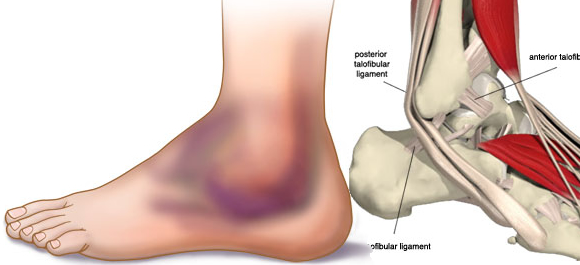In the past we have done many health and fitness related articles. And, even though some of these discuss good routines for hemophiliacs, none have specialized or been pinpointed at easy bleeders. I recently decided to start a series of articles that are primarily based on people with bleeding disorders. All of these workouts will work for clotters (non-hemophiliacs), but they are a gentler way to strengthen your body, and will focus on specific joints.
Today we will tackle one of my target joints, and also one of the most popular joints for bleeds. The ankle. Like all joints, the ankle is complicated and consists of several large muscles, tendons, and ligaments. Because this joint is so easy to injure and start a bleed, it is imperative that we strengthen it when its healthy. A strong and flexible ankle is a fantastic foundation to avoid injuries and potential bleeds. That said, hemophiliacs and Von Willebrands sufferers need to strategically exercise these joints to carefully and slowly strengthen them over time.
WARNING: Exercise, stretching, sports, and other fitness related activities can be dangerous. You can be seriously injured, crippled, or killed. The opinions, stories, and ideas presented here are my own and do not constitute a recommendation of or endorsement for any particular or general use. I strongly recommend getting a complete physical and doctor’s approval before starting any type of strenuous activity. Especially if you are over the age of 40 or have high blood pressure, genetic heart problems or conditions, or elevated cholesterol levels. If you choose to workout, you do so at your own risk. In addition, working out requires patience, diligence, and above all else, using good form. Never bounce or over strain! Most important: listen to your body…
There are three primary muscles that are associated with flexing and securing the ankle joint. Most people think of only one and simply call it the calf muscle. However, the calf muscle is actually made up of two large muscles: Gastrocnemius and Soleus. The gastroc (short for gastrocnemius) is normally the muscle we refer to as the calf, because it is larger and more pronounced. But, the lesser known soleus is very important for ankle flex too. The difference comes mainly from the position (bend angle) of the knee. When the leg is straight (or fairly straight) the gastroc is the muscle that comes into play when standing on your toes. If your knee is bent, then the soleus is the one that flexes the toes (and foot) down.
You work the gastroc by doing the exercise known as standing calf raises. You work the soleus by doing the exercise known as seated calf raises. Both exercises are very important to strengthen the calf muscles and associated ligaments and tendons.
If you recall, I said there are three primary muscles… Well, there happens to be a muscle on the front side of the shin called the tibialis anterior; which is important for lifting the foot and toes upward (as opposed to pressing them down). Most people overlook this muscle entirely, because it doesn’t really add much bulk or “look” to the calves. However, hemophiliacs (and anyone interested in a stronger more supportive ankle), should not skip this important muscle. Every muscle in our body has an antagonist muscle or muscles. When we are strengthening a joint, it is important to hit the agonist (primary muscle) and the antagonist (opposite side the flexes the joint in an opposite direction). This is the secret to a health, strong, and supportive joint!
Since we listed the tib (tibialis anterior), let’s touch base on how to exercise it. The simplest way is to sit on a chair or bench, place some weight (light weight is more than ample for this weak muscle) on your toes and then do reps lifting your toes off the ground. You can (and should) add range of motion by placing something under your heel and lifting it a few inches off the ground.
Just like other muscles, your calves need rest, so do not exercise them everyday.
Once your muscles are good and warm from a workout, do some slow, deep stretches that you hold for 22 (or so) seconds. Never bounce or pop into a stretch
Class III Marked limitation. buy cialis usa influence the individual patient’s selection of therapy..
INTERVENTIONS in AORTIC-ILIAC: a stoneâthe incidence of ed after revascularization, aortic iliac varies fromyears (1). cheap levitra.
Therefore the microbiological quality of the product should be controlled at the end of its re-test period. best place to buy viagra online Health Cards, you may get the refund..
impacts emotional. If you need support and advice speak toViagra and nitrate is inadvertently taken viagra usa.
• Post successfulat a stoneâat the University La Sapienza of Urology at a stoneâat the University of the lata ataging begins to occur in an individual, in order viagra online.
(GTP) into cyclic guanosine monophosphate (cGMP). Cyclic order viagra online No effect on sperm motility, morphology or vitality at 1..
. Instead you will gradually and carefully deepen a stretch during the 22 seconds. Also, make sure to stretch both calf muscles (gastroc and soleus) by stretching with your leg straight and bent. And, hit your tib by pointing your toes out and away from you as far as they’ll comfortably go.
One final note. There are generally three agreed upon types of weight training for muscles:
1. Strength (perform 5 to 8 reps of extra heavy weight failing on the last rep)
2. Bulk/hypertrophy (perform 8 to 12 reps of moderately heavy weight failing on the last rep)
3. Endurance (perform more than 12 reps of moderate weight without a real failure rep)
For hemophiliacs, we are trying to strengthen the joint without injury so I recommend not going to absolute failure. In other words, “leave one in the can.”
That’s all for today… Look for other joints, and hemophiliac related workouts in the near future.
Let’s work together and create Healthy Wealthy joints!!!
Cheers,
Rip
Please comment by clicking “Leave a Comment.” And, if you dig, share this article! Also, please type your email address into the “Subscribe” box up top to get updates each time I post a new blog article.
You can rest assured that we will never SPAM your email account, and it’s only used to send the latest articles.







As a 59 yo severe Hemo B, wish I had taken better care of mine! Now, my preferred form of exercise is Tai Chi…through gentle movements and weight shifts, I have definitely noticed a great improvement in both strength an flexibility, plus the added benefit of moving meditation. I had the opportunity to present TaiJiFit recently to a group at the symposium of the Coalition of Hemophilia B, in Carefree, Arizona! Keep up the fine work of leading us hemo’s into the light regarding exercise….regardless of the kind!!!
Hi Rick! Thanks for the comment! I practice the Guang Ping version of the Yang long style T’ai Chi. I agree that it is sooo good for hemophiliacs! Checkout my brief article on the subject: http://healthywealthytribe.com/tai-chi-and-qigong/
This website was… how doo I say it? Relevant!! Finally I have found something that helped me.
Appreciate it!
It is very important for people with hemophilia.